Desktop Tips
Tip #158
November 25, 2022
Add web calendars to Vivaldi Calendar to view publicly shared events and schedules.
Web calendars, for example local public holidays or your favorite sports team’s match calendar, are a good way to follow events that you don’t want to add manually yourself, but would still like to know about. Web calendar events are read-only, meaning you can view them, but only the calendar owner can edit the events.
To subscribe to a web calendar from a website:
- Look for a Subscribe or similarly named button or link and click on it. Vivaldi Calendar will detect the action and offer to import the events.
- Select the calendar you want to import the calendar events to or create a new one.
- Click Import.
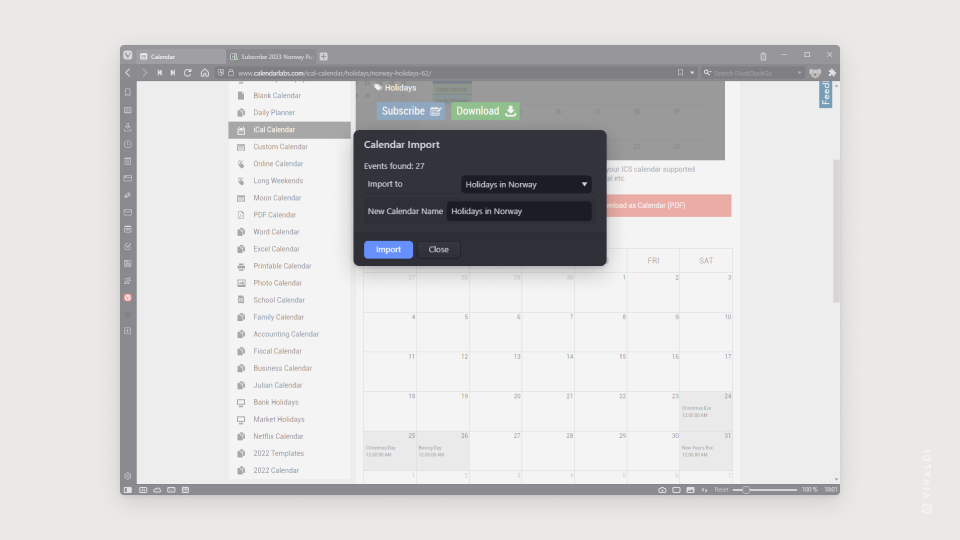
To manually add a web calendar:
- Go to Settings > Calendar > Calendar Accounts.
- Add a new account and select Web Calendar.
- Click Continue.
- Give the Calendar account a name.
- Enter the calendar’s link (make sure the URL ends with .ics).
- If the web calendar has limited access, enter your username and password. In case it’s a public calendar leave the username and password fields empty.
- Click Add Account.
- Select the calendars you want to sync with Vivaldi Calendar, which one’s to hide and which one is the account’s default calendar.
- Click Done.
Tip #156
November 23, 2022
Declutter a crowded Tab Bar by stacking all tabs by hosts.
While actively browsing, it’s easy to accumulate a large number of tabs. To keep things in order and tabs easy to find, it’s good to group them together. In Vivaldi you can group all tabs from the same domain (e.g. vivaldi.com) with just two clicks.
To stack tabs by hosts:
- Right-click on a tab.
- Select Stack Tabs by Hosts.
Tip #154
November 21, 2022
Set your favorite web page as the homepage for Vivaldi on desktop.
By default, when you click on the  Go to homepage button on the Address Bar, you’ll be taken to the browser’s Start Page. If there’s a web page that you visit all the time, you could set that as the homepage instead. To do that:
Go to homepage button on the Address Bar, you’ll be taken to the browser’s Start Page. If there’s a web page that you visit all the time, you could set that as the homepage instead. To do that:
- Go to Settings > General > Startup > Homepage.
- Select Specific Page.
- Enter the URL of the page you want as your homepage.
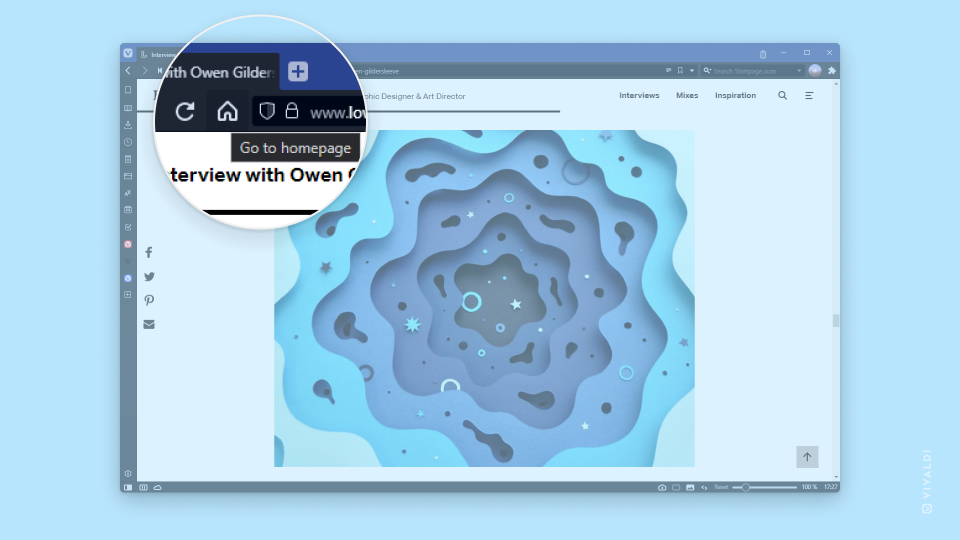
Tip #153
November 18, 2022
Open History to get a visual overview of the web pages you’ve visited.
In Vivaldi your History of visited web pages is not just an endless list. Instead History in Vivaldi is a detailed overview backed by statistics and presented in a nice, visual way.
To view your full history, use one of the following options to open the page:
- Click on History on the top menu of the Start Page.
- Go to
 Vivaldi menu > Tools > History.
Vivaldi menu > Tools > History. - Enter vivaldi://history in the Address Field.
- Type “History” in Quick Commands.
- Right-click on the
 History Panel button and select Open in > New Tab.
History Panel button and select Open in > New Tab. - Use the Keyboard Shortcut Ctrl H / ⌘ Y.
Switch between the different views (List, Day, Week and Month) from the top right corner to see not just the pages you’ve visited but also statistics, which show you your browsing activity, when you were most active, what kind of websites you visited and how you ended up there.
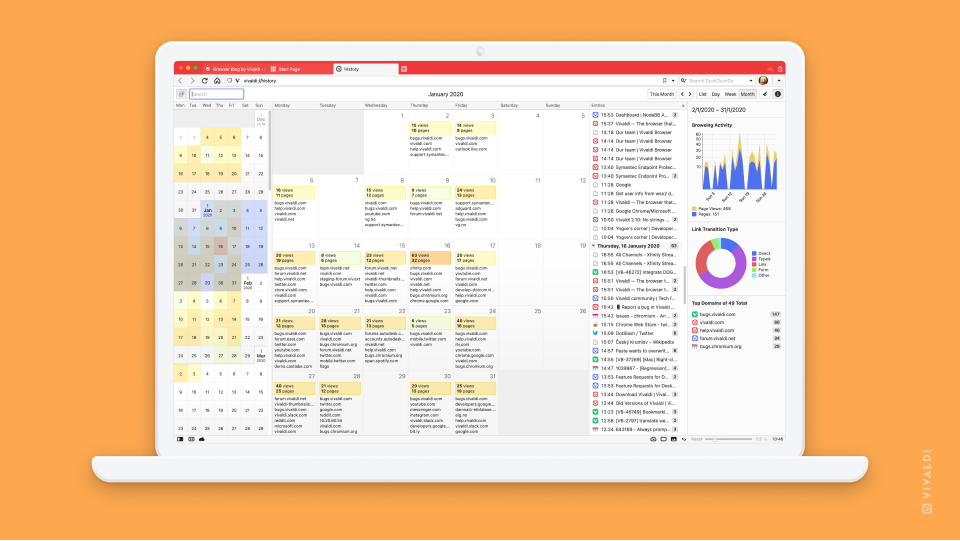
Tip #152
November 17, 2022
Share your custom browser theme with the community on themes.vivaldi.net.
Creativity has no limits and with the Themes editor in Vivaldi, you can let it run wild. Change the colors, add a custom background, tweak the settings and you have yourself a custom theme. Would be a shame to keep it to yourself. Themes.vivaldi.net is the place where Vivaldi users can share their creations with the community and already over 3000 themes have been published on the website.
Here’s how you can share your theme:
- Go to Settings > Themes > Library and select the theme you want to share.
- Click on Export Theme below the themes.
- Save the ZIP file to your computer.
- Go to Vivaldi Themes on https://themes.vivaldi.net.
- Log in to your Vivaldi account.
- Click Upload in the top right corner of the page.
- Fill in the details about the theme (in English) and upload the ZIP file.
- When you’re ready, click Create theme.
Vivaldi Team will review your theme and publish it. You’ll be notified once the theme has been published (also, when for some reason, the theme was rejected).
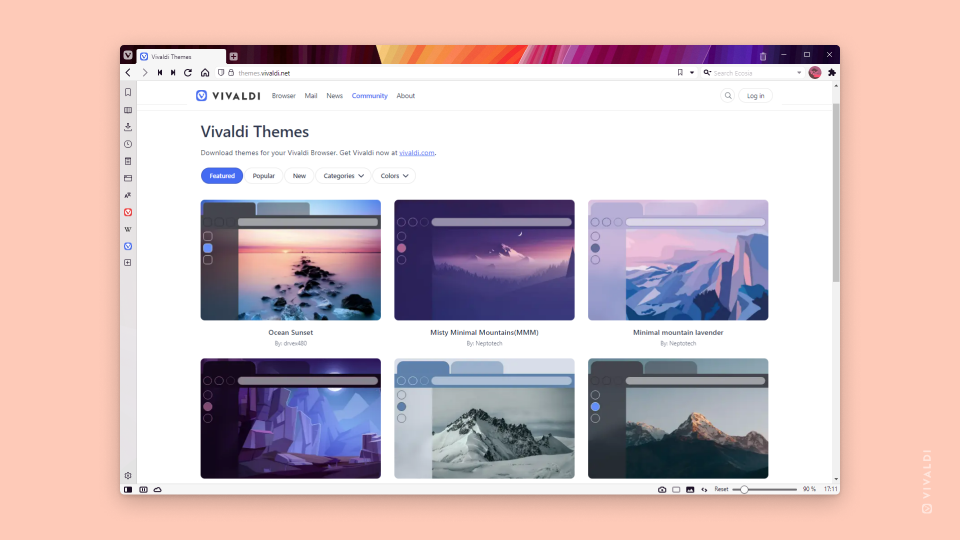
Tip #149
November 14, 2022
Download the backup encryption key to be able to restore access to synced data even when you have forgotten the encryption password.
Backup encryption key is an alternative method to the encryption password for decrypting your Sync data. Like with the encryption password, your backup encryption key is never sent to us or any other third party, which ensures that we cannot decrypt your data. For it to be useful, you need to save the key in a safe location, while you can access your Sync settings with the encryption password.
Save the backup encryption key
- Log in to your Vivaldi account in Settings > Sync.
- Enter the encryption password.
- Below your account info, look for Save Backup Encryption Key. On Android, look for Backup Encryption Key near the bottom of the Settings page.
- Click on it and save the key file to your device.
The key is valid until you reset the remote Sync data. We recommend storing the key file in a location that can survive something irreparable to your device, such as an external memory drive or a trusted cloud service.
Use the backup encryption key
- Log in to your Vivaldi account in Settings > Sync.
- When asked for the encryption password, click Load Encryption Key.
- Click Load and find the key file.
- Click Open.
- Start syncing.

Tip #148
November 11, 2022
Double-click on a Mail or Feeds message to open it in a new tab.
Need to work more with an email than just read through it? Double-click on the message to open it in a new tab. That allows you to keep the message open while checking other emails and use browser features, such as pinning, grouping, tiling (shown on the screenshot below), and more on the tab.
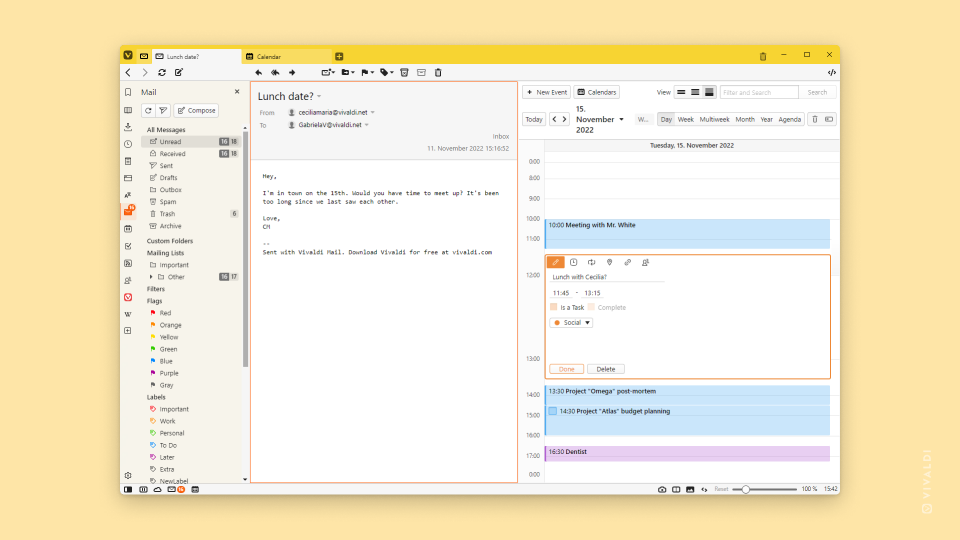
Tip #145
November 8, 2022
Close tabs with a double-click or middle mouse button click on the tab.
There are more ways to close tabs in Vivaldi than can be counted on one hand. In this tip post we’ll introduce you to two lesser known options.
Option 1 is to double-click on the tab with the left mouse button. It works best when you want to close the active tab, but can be used to close background tabs as well. To use this option, first go to Settings > Tabs > Tab Handling and enable Close Tab on Double Click.
Option 2 is to click on the tab with the middle mouse button (commonly mouse’s scroll wheel). It works in the Window Panel as well.
To see other ways to close tabs in Vivaldi, visit the Help page about Opening and closing Tabs.
In case you got carried away with closing tabs, check Tip #95 to see how to reopen recently closed tabs.
Tip #144
November 7, 2022
Cast your browser content to a TV screen with a Chromecast device.
If you have a Chromecast device connected to your TV, you can display audio-visual content, browser tabs or even your computer’s whole screen from Vivaldi on the TV screen.
To start casting:
- Make sure your Chromecast is set up and ready to use.
- Right-click on the web page or go to
 Vivaldi menu > File.
Vivaldi menu > File. - Select Cast.
- Choose whether you want to cast a file, a tab or mirror your desktop.
- Click on the device you want to cast to.
Some websites detect a Chromecast connection and display the casting option on the website. Look for the  Cast button, for example, on a video player’s menu.
Cast button, for example, on a video player’s menu.
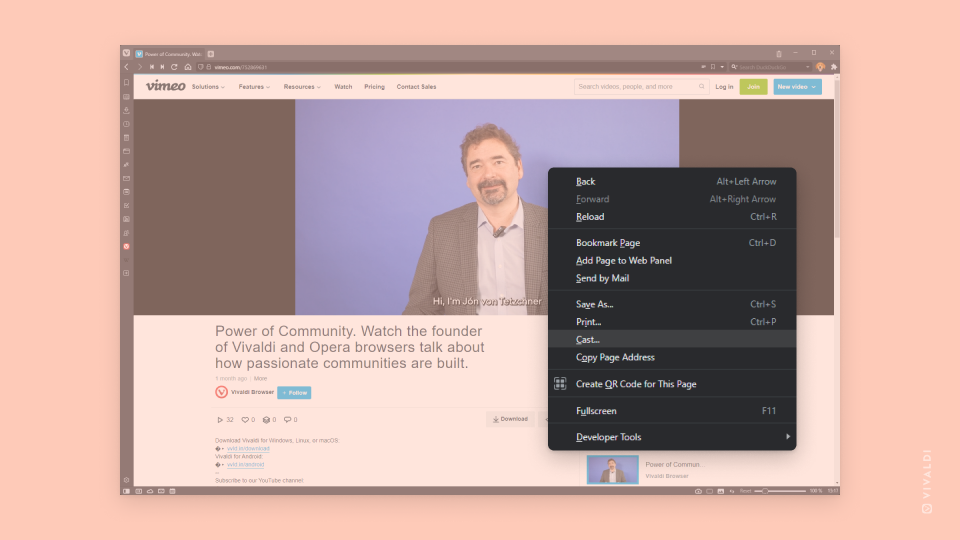
Tip #143
November 4, 2022
View saved passwords in Privacy Settings.
Unless you’ve disabled it from Settings, Vivaldi offers to save your login passwords in the browser. Your password is also saved when you use Vivaldi’s Sync, Mail and Calendar features.
To view saved login credentials on desktop:
- Go to Settings > Privacy > Passwords.
- Click on Show Saved Passwords.
- In the table of saved login credentials, click on
 Show Password in the passwords column.
Show Password in the passwords column. - Verify yourself through your operating system’s authentication window.
- Check the password.
- When done, click on
 Hide Password.
Hide Password.
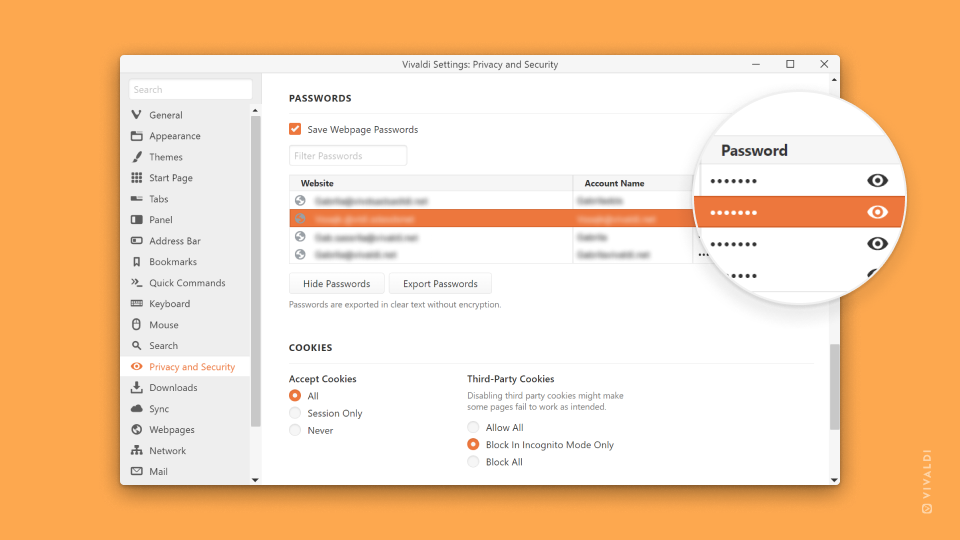
To view saved login credentials on Android.
- Go to the
 Vivaldi menu > Settings > General > Passwords.
Vivaldi menu > Settings > General > Passwords. - In the list of saved login credentials, tap on the saved login.
- Click on
 Show Password on the right side of the saved password.
Show Password on the right side of the saved password. - Verify yourself through your mobile device’s authentication window.
- Check the password.
- When done, click on
 Hide Password.
Hide Password.
You also need to verify yourself when copying the password without viewing it first.
Tip #142
November 3, 2022
Send emails as any of your mail accounts in Vivaldi Mail and swiftly change between them.
If you have set up multiple mail accounts in Vivaldi Mail, you can switch who you’re sending emails as in the message composer.
- Start writing a new email, either by composing a new message or by replying to/forwarding a received message.
- In the email composer, in the sender section (From:), click on the displayed email.
- Select the email address you want to send the message as from the drop down menu.
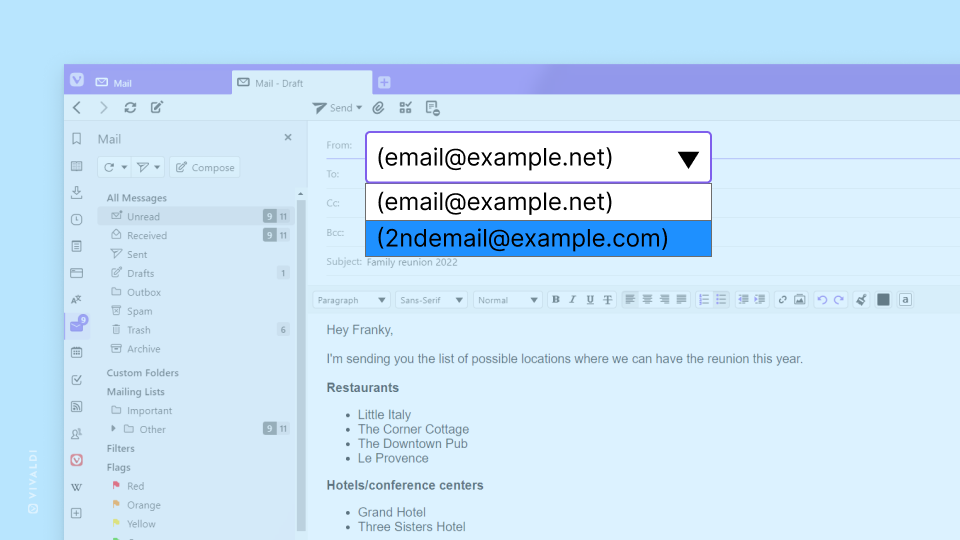
Tip #140
November 1, 2022
Adjust Mouse Gesture sensitivity to avoid executing commands by accident.
If you’ve noticed yourself using Mouse Gestures without intending to, for example, reloaded a web page with a slight drag downwards instead of just right-clicking on it, increase the stroke length to prevent it from happening. To do that:
- Go to Settings > Mouse > Gesture Sensitivity.
- Update the minimum stroke length.